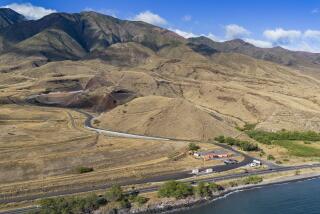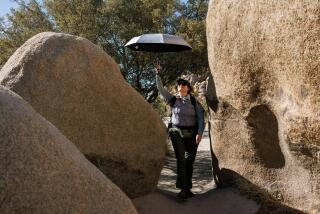Lucky are the visitors to Volcanoes National Park on Hawaii who are on hand to witness the dramatic eruptions of the craters on Kilauea and watch while Madame Pele shows her authority by throwing a spectacular tantrum. : Pele’s Fury
- Share via
HAWAII VOLCANOES NATIONAL PARK — It’s Hawaii without the grass skirts, surfboards and hula. Instead, calderas steam in vast fields of lava, punctuated by specter trees rising stark and lifeless from their brittle base.
Macbeth’s witches would feel right at home here in the surreal landscape that seems a long way from the other side of paradise, a landscape decorated by Hawaiian goddess Madame Pele in her favorite color--basic black.
Yet not far in any direction, the lush vegetation of Hawaii blankets the earth in the verdant carpet of a tropical terrain. This is our most explosive national park. Those who would like a visit to another small planet without the astronomical cost of a space shuttle would do well to see this park on the youngest and largest of these Islands, the Big Island, Hawaii.
The rocky terrain of the mountain park is indeed an alien world. But this is a friendly alien with temperate weather, wind orchids and ohelo berries to welcome guests.
Nor do Hawaii’s volcanoes have the nasty temper of a Mt. St. Helens. Hawaii’s are shield volcanoes, a type that erupts in a manner suitable to paradise. Instead of fleeing from the lethal fiery cloud of composite and cinder cone volcanoes, thousands flock to Hawaii to watch the eruptions of its volcanoes.
For visitors who miss one of the eruptions, movies and exhibits at the Visitors Center provide a graphic substitute for a ringside seat at the building of a mountain.
The best place to begin a visit to the park is at the Visitors Center, which is at 4,200 feet next to Kilauea caldera. There you can see films of a lava fountain as high as the Empire State Building. Or you can watch fat, lazy-looking lava as it oozes its way downhill like fiery-hot fudge.
When the lava meets the sea, it makes a fury of steam. According to legend, Hawaii’s volcanic activity is controlled by Madame Pele, eater of trees, maker of mountains, router of war gods. The feisty goddess was briefly married to Kamapuaa, god of war. It may have been a match made in heaven, but its duration was short and violent.
In a rage, Pele routed Kamapuaa from her crater of fire and chased him with streams of lava into the sea.
Madame Pele’s union with the National Park Service is a good deal more friendly. She obliged them by placing a kapu (taboo) on taking any lava from the park. A central exhibit at the Visitors Center chronicles the woes of those who break the kapu .
With his returned lava, one such visitor wrote:
This purloined chunk of black basalt
Has stirred your wrath.
It’s all my fault.
I hate to contemplate its cost;
The airline tickets that we lost;
Six pairs of shorts dyed purplish-blue
When laundered with my wife’s muumuu ...
The kitchen sink that stopped up tight
As guests arrived the other night.
Are we forgiven, Pele?
Shake!
Good Lord--a six-point-seven quake!
A chat with park personnel such as chief naturalist Tom White provides an excellent orientation to the wonders that lie outside the Visitors Center. According to White, the center seeks to excite visitors’ curiosity about the park and give them a basic understanding of the natural and cultural history of the area.
Explaining the park wonders is important because for the 2 million people who visit the 229,177-acre park each year, the average stay is only two hours; many whiz past the spectacular scenery in tour buses.
White points out that in many of our parks interpreters talk about a natural process that happened hundreds of thousands of years ago, but in this park these processes may be happening as he speaks.
In 1984, lava gushed from Mauna Loa and Kilauea at the same time, and on Nov. 13, 1985, Kilauea began a spectacular seven-hour performance.
In such explosive times, the park maintains a hot line: (808) 965-7977. But White warns those who wish to rush to the park to see an eruption that many are very brief; airlines book almost instantly when Madame Pele is in action.
Visitors Center displays also show the park’s flora and fauna. The displays include a lesson in what happens when man meddles with nature. The original Hawaiians brought with them pigs that ate the eggs of ground-nesting birds. The bad-guy pigs also routed out basins in trees.
When mosquitoes bearing a strain of malaria fatal to many native birds arrived with Western man, the rainwater that collected in the basins formed breeding areas for the mosquitoes.
So special and fragile is the native flora and fauna of Hawaii that half of the species on the endangered species list are found only in Hawaii.
Displays also give a sense of an island culture that flourished long before Capt. James Cook sailed into Kealakakua Bay in 1778 and claimed the Sandwich Islands for Britannia.
Dressed in Hawaii’s version of the National Park Service uniform--a muumuu--interpreters such as Candy Hoopii show visitors how Hawaiians used native plants.
For those with limited time in the park, Hoopii recommends the 11-mile Crater Rim Drive, a road that passes a spectrum of the park’s attractions such as tropical rain forests and forests of lava trees, eerie worlds in which lava has hardened around trees before consuming them with fire. Hollow black lava chimneys stand where once a tropical forest flourished.
Elsewhere a volcanic desert stretches where nature’s acid rain has left a barren landscape. Here and there steam rises from the ground in a ghostly vapor. At Sulphur Banks the earth sends forth gases that stir memories of Chemistry 101.
Kipuka Puaula bird park is a great place for watching either native birds or bright-shirted binoculars bearers. So far this gentle forest has been spared the devastation of scalding lava, so the mighty koa trees still stretch their moss-covered branches and form perches for colorful birds such as the red-feathered, curved bill i’iwi, whose ancestors furnished feathers for the capes of Hawaiian royalty.
At Volcano Observatory, U.S. Geological Survey seismographs show off for visitors as scientists keep track of Pele’s activities. From the observatory the view across Kilauea’s 3,000-foot-wide, 400-foot-deep Halemaumau fire pit is spectacular. Until it blew its lid and drained in 1924, Halemaumau, the world’s most active volcano, was a year-round Fourth of July and Halloween rolled into one.
In 1866 Mark Twain wrote: “It looked like a colossal railroad map of the state of Massachusetts done in chain lightning shivered into a tangled network of angry fire.” Frequently the railroad map reappears, as it last did in April, 1982.
For those with more time to spend at the park, the swoops and curves of Chain of Craters Road furnish an advanced geology lesson. White calls the 28-mile trek “one of the world’s most unusual and beautiful roads.”
Buried until recently by masses of lava, the road snakes downhill to the coast and the Wahula Visitors Center. Amid the shiny black, blown-glass stripes of fresh lava are older flows where ancient Hawaiians carved petroglyphs into the stone.
Black-Sand Beaches
In other places, lava lakes drained, leaving deep craters as the brittle crust collapsed. Other attractions include the surf at work turning lava cliffs into black-sand beaches and an ancient heiau (temple) where human sacrifices were made.
Following this route, visitors can leave the park and head for Hilo. For those who stay in the park, Volcano House is the only hotel in town. It has 37 rooms and looks as if it hasn’t been refurbished since it was built in 1941. The hotel is clean, genteel and comfortable as well as funky. And where else can you watch a steaming caldera while you sip Kona coffee and munch muffins topped with ohelo berry jam? The hotel even has a volcanic steam bath.
On a cold, rainy night few bars are cozier than Uncle George’s, and in the hotel lobby, a mountain-size, lava-rock fireplace warms guests as they relax in overstuffed brown couches and chairs. A roaring blaze on a tropical island dotted with steaming calderas might seem like coals to Newcastle, but the mountain air can be nippy, especially at night. The hotel also manages 10 A-frame tent cabins.
Huts for Hikers
The park service has several campgrounds available on a first-come, first-serve basis (White says they rarely fill up). In addition, back country huts shelter persons hiking those little-used trails. (If you plan to hike in the park, take along sturdy shoes. Volcanic rock could hold its own against a switch-blade knife.)
The park has several picnic sites, but those who wish to buy food in the park are limited to Volcano House and the clubhouse for the nearby golf course, which serves three meals daily.
Because Hilo (a 40-minute drive from the park) is on the rainy side of the island, most flights now go into Kona. The drive from Kona is a pleasant three-hour jaunt through cane fields and macadamia nut plantations and past important sites such as City of Refuge Park. And that red glow on the horizon? It may well be Madame Pele’s warm welcome to her explosive paradise.
Volcano House: double rooms from $51 a night (crater view, main building) to $40 (parking lot view, annex), $10 more for each additional person in a room (maximum four people).
A-frame cabins: $16 a night double, $3 for each additional person for linens (maximum four people per cabin). Cabins have a double bed, bunk bed and a light bulb, but no electrical outlets. The bath is down the trail.
Reservations with a deposit are a must for all accommodations; 72 hours’ cancellation notice is required for a refund. Information: Hawaii Volcanoes National Park, Hawaii 96785; (808) 967-7321.
The campgrounds are free. The park entry fee is $5 per car, $2 per person on a tour bus or motorcycle.
White says the lava is flowing at 6,500 cubic feet a day. He predicts that the lava will be flowing for a long time. Lava already covers 1 3/4 miles of the end of Chain of Craters Road. The flow is about a mile from the road.
More to Read
Sign up for The Wild
We’ll help you find the best places to hike, bike and run, as well as the perfect silent spots for meditation and yoga.
You may occasionally receive promotional content from the Los Angeles Times.






